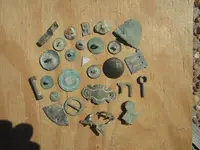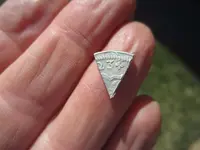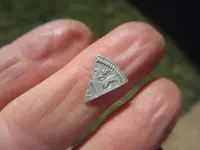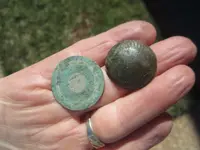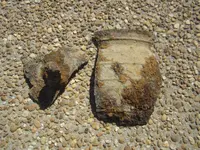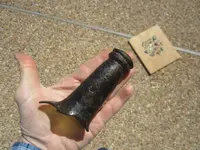Bill D. (VA)
Silver Member
- Joined
- Oct 7, 2008
- Messages
- 4,711
- Reaction score
- 6,212
- Golden Thread
- 6
- Location
- SE Virginia
- 🥇 Banner finds
- 6
- 🏆 Honorable Mentions:
- 2
- Detector(s) used
- F75 SE (land); CZ-21 (saltwater)
- Primary Interest:
- Other
My digging buddy Dan and I have been itching to get back to the money pit he discovered 2 weeks ago that produced several colonial silver and copper coins, quite a few buttons, some nice pottery, and an array of iron artifacts. Our intent was to finish digging the pit out to its edges and floor, and then sift all the dirt. But as Mother Nature would have it, yesterday’s weather was miserable (windy, rainy, with temps dropping to 40F). But it wasn't quite bad enough to deter us from getting out, and we opted to begin the day checking out one of our other nearby sites that had produced a few 18[SUP]th[/SUP] century relics a couple months ago. After not much luck there we decided to scout 3 other nearby fields that we had permission for, but none were productive.
At that point we decided to head over to the money pit site for a little digging and eyeballing since the ground was way too wet for any sifting. But just trying to get to the site was a major effort as we had to cross 500 ft of a recently deep plowed, sandy field after almost 2” of rain. Every step was difficult, and you never knew when that next step would get you bogged down to your knees. I had to use my shovel several times to help pull myself free. It was quite a struggle, and I’m glad Dan didn’t turn around and start shooting a video of me floundering in that quagmire – what a sight that would have been! We finally made it to the knoll where the pit was located, and the dirt in that area was much more firm. After spending a few hours of excavation we finished digging it out, but were a bit disappointed that no new coins were found. But while scanning during the backfilling process we were able to recover about 10 buttons along with other misc brass and pottery that had somehow been missed during the excavation process. But this was the result of significant target masking due to the tremendous amount of iron in the use layer. We feel confident that once we come back to sift when things dry out that more finds will be made, and hopefully some of those will be coins. We also pulled out some nice 18[SUP]th[/SUP] century pottery shards that will match up with some of those dug earlier. So we have some interesting pottery reconstructions to perform, and Dan is the point man on that.
We occasionally took breaks to do a little surface hunting in the immediate area, but the finds were rather slim since we’d hit this area hard already. But I did get lucky and unexpectedly popped out a nice little cut piece of silver – a small “piece of pie” bit from a 1 reale that fortunately had the date (1723). This was the 11[SUP]th[/SUP] Spanish silver coin we’ve dug from this site in 2 years not to mention all the colonial coppers. I also found another small trash pit and dug 2 big pieces from a large iron pot which will soon make their way into the electrolysis tank. By then it was starting to get late and the weather was looking even more ominous so we called it a day. We made it back to the truck via a longer, yet much less taxing route as I wanted no repeat of my earlier quicksand adventure. With the weather turning much warmer and drier this week we hope we can soon return to finish the job before planting begins.
At that point we decided to head over to the money pit site for a little digging and eyeballing since the ground was way too wet for any sifting. But just trying to get to the site was a major effort as we had to cross 500 ft of a recently deep plowed, sandy field after almost 2” of rain. Every step was difficult, and you never knew when that next step would get you bogged down to your knees. I had to use my shovel several times to help pull myself free. It was quite a struggle, and I’m glad Dan didn’t turn around and start shooting a video of me floundering in that quagmire – what a sight that would have been! We finally made it to the knoll where the pit was located, and the dirt in that area was much more firm. After spending a few hours of excavation we finished digging it out, but were a bit disappointed that no new coins were found. But while scanning during the backfilling process we were able to recover about 10 buttons along with other misc brass and pottery that had somehow been missed during the excavation process. But this was the result of significant target masking due to the tremendous amount of iron in the use layer. We feel confident that once we come back to sift when things dry out that more finds will be made, and hopefully some of those will be coins. We also pulled out some nice 18[SUP]th[/SUP] century pottery shards that will match up with some of those dug earlier. So we have some interesting pottery reconstructions to perform, and Dan is the point man on that.
We occasionally took breaks to do a little surface hunting in the immediate area, but the finds were rather slim since we’d hit this area hard already. But I did get lucky and unexpectedly popped out a nice little cut piece of silver – a small “piece of pie” bit from a 1 reale that fortunately had the date (1723). This was the 11[SUP]th[/SUP] Spanish silver coin we’ve dug from this site in 2 years not to mention all the colonial coppers. I also found another small trash pit and dug 2 big pieces from a large iron pot which will soon make their way into the electrolysis tank. By then it was starting to get late and the weather was looking even more ominous so we called it a day. We made it back to the truck via a longer, yet much less taxing route as I wanted no repeat of my earlier quicksand adventure. With the weather turning much warmer and drier this week we hope we can soon return to finish the job before planting begins.
Attachments
Upvote
19



